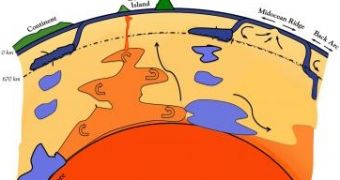We know how the seven continents are arranged today and we are aware (and it's easy to observe) that they were once grouped up in a single, massive continent, called Pangaea. But what's the mysterious force that caused the division of the continents and keeps moving them apart? New studies associate the continental spreading with the existence of two colossal superplumes, one situated under Hawaii and the other below the African crust.
The superplumes are massive conglomerates of extremely hot rock, much larger than regular plumes, lying way below the surface of the planet, more or less close to its core. In a recent article, we have written about one negative impact that such a superplume could have on the Earth when it reaches the surface as supervolcanoes, namely that it threatens to extinguish nearly all life. But it seems that staying underground is not without consequences either, as members of the Cooperative Institute for Deep Earth Research (CIDER) showed.
Each of the over 200-million-year old superplumes is greater than the US and lies amidst layers of plates sunken into the mantle from the planetary crust. Wendy Panero, an assistant professor of earth sciences at Ohio State University, who shares her knowledge on mineral physics with CIDER, calls them "superpiles," but is not yet sure which one influences the other.
"Do these superpiles organize plate motions, or do plate motions organize the superpiles? I don't know if it's truly a chicken-or-egg kind of question, but the locations of the two piles do seem to be related to where the continents are today, and where the last supercontinent would have been 200 million years ago," shared Panero, cited by esciencenews. CIDER scientists did find, however, that the superplumes stay in place, slowing down seismic waves, while the rest of the magma flows around.
Their theory is that tiny differences, such as the iron content in the superpiles (11-13%) comparing to the rest of the mantle (10-12%) makes them heavier and holds them in place. "Material that is more dense is going to sink to the base of the mantle," explained Panero. "It would normally spread out at that point, but in this case we have subducting plates that are coming down from above and keeping the piles contained." Further study will determine whether the superplumes are also responsible for the breaking of Pangaea.

 14 DAY TRIAL //
14 DAY TRIAL //